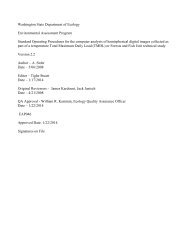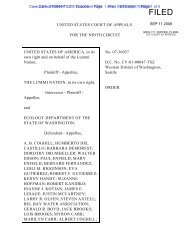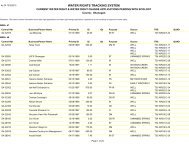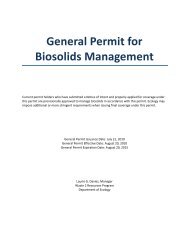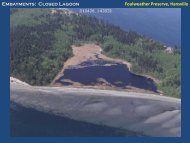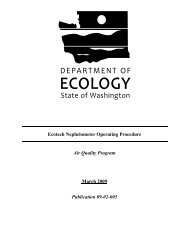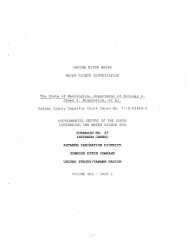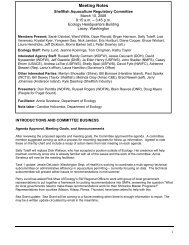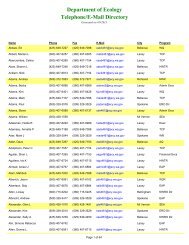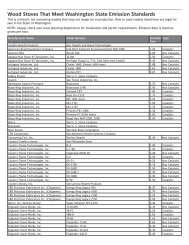WRIA 62 WMP 032305 - Washington State Department of Ecology
WRIA 62 WMP 032305 - Washington State Department of Ecology
WRIA 62 WMP 032305 - Washington State Department of Ecology
You also want an ePaper? Increase the reach of your titles
YUMPU automatically turns print PDFs into web optimized ePapers that Google loves.
March, 2005 -7- 023-1289-003.3040<br />
The Watershed Planning Act (Chapter 90.82.RCW) describes watershed planning as four separate<br />
components; Water Quantity, Instream Flow, Water Quality, and Habitat. The scope <strong>of</strong> watershed<br />
planning must include the Water Quantity component in order to qualify for grant funding under this<br />
Chapter. The remaining three components are optional. The four planning elements are detailed<br />
below:<br />
• The water quantity component <strong>of</strong> the plan is mandatory and addresses water quantity by<br />
assessing water supply and use in the watershed and developing strategies for future use<br />
(RCW 90.82.070). Watershed plans must address quantity with strategies that would<br />
supply adequate instream water for fish and out-<strong>of</strong>-stream water for future uses and/or<br />
development.<br />
• The water quality component addresses water quality in the watershed by synthesizing<br />
current available data, and gathering metadata on current and historical water quality<br />
programs and studies. The intent <strong>of</strong> this component is the development <strong>of</strong> watershedwide<br />
assessment <strong>of</strong> water quality and local approaches for monitoring and Total<br />
Maximum Daily Load (TMDL) implementation.<br />
• The habitat component guides plan development to consider protection and enhancement<br />
<strong>of</strong> fish habitat. This component, as per RCW 90.82.100, “must rely on existing laws,<br />
rules, or ordinances created for the purpose <strong>of</strong> protecting, restoring, or enhancing fish<br />
habitat, including the Shoreline Management Act (Chapter 90.58 RCW), the Growth<br />
Management Act (Chapter 36.70A RCW), and the Forest Practices Act (Chapter 76.09<br />
RCW)”.<br />
• Instream Flows are defined as scientifically-based surface water flows set by<br />
administrative rule to ensure adequate water for fish, other instream values and senior<br />
out-<strong>of</strong>-stream beneficial uses. This planning component is designed to set minimum<br />
instream flows for streams within the watershed. If the Planning Unit chooses not to<br />
address instream flows, in the planning process, setting <strong>of</strong> instream flows could be taken<br />
on by <strong>Ecology</strong><br />
2.1.2 General Obligations and Expectations<br />
In general, Watershed Management Plans will be used to guide future water management in<br />
participating <strong>WRIA</strong>s. <strong>Ecology</strong> and the Planning Unit expect to use the actions recommended in this<br />
plan to aid water management decisions in <strong>WRIA</strong> <strong>62</strong>.<br />
When the Watershed Management Plan is approved by the Planning Unit and participating <strong>State</strong><br />
agencies, <strong>Ecology</strong> will be obligated to integrate Plan actions into strategies and will be required to<br />
track its work obligations. The following sections from the 2003 update <strong>of</strong> Chapter 90.82 RCW<br />
provide details and directives to agencies and organizations about Plan obligations and expectations:<br />
<strong>WRIA</strong> <strong>62</strong> <strong>WMP</strong> <strong>032305</strong><br />
• RCW 90.82.130(3)(c) “for an organization voluntarily accepting an obligation,<br />
the organization must adopt policies, procedures, agreements, rules, or<br />
ordinances to implement the Plan and should annually review implementation<br />
needs with respect to budget and staffing.”<br />
• RCW 90.82.130(4) “After a Plan is adopted…the department (<strong>of</strong> <strong>Ecology</strong>) shall<br />
use the Plan as the framework for making future water resource decisions for the



